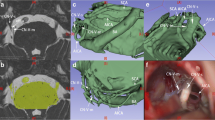Abstract
High-resolution magnetic resonance imaging (HR-MRI) using three-dimensional fast imaging employing steady-state acquisition (3D-FIESTA) and double-dose contrast-enhanced three-dimensional fast spoiled gradient echo (3D-FSPGR) sequences is considered to be a useful tool in detecting neurovascular compression in patients with trigeminal neuralgia. The purpose of this study was to analyze the accuracy and preoperative diagnostic value of these high-resolution imaging techniques in patients with trigeminal neuralgia, in a single-blind study. The preoperative MRI images of 21 consecutive patients were matched to one neuroradiologist, who was blind as to which side exhibited the symptoms. The images and post-processing multiplanar reconstructions were compared with the video-documented operative observations. HR-MRI using only 3D-FSPGR sequences demonstrated neurovascular compression in accordance with the intraoperative finding in 11 patients (52.4%). In the subgroup where, additionally, 3D-FIESTA sequences were available, neurovascular compression was in accordance with the intraoperative finding in 71.4% (n=7). High-resolution magnetic resonance imaging using double-dose contrast-enhanced 3D-FSPGR and 3D-FIESTA sequences is currently not sufficient enough to make an accurate prediction of neurovascular compression in a single-blind setting. These 3D imaging techniques currently provide only limited information, and one should consider their use carefully when identifying patients with trigeminal neuralgia from operation until image quality is improved by superior image resolution that can accurately discriminate vessels surrounding the trigeminal root entry zone.



Similar content being viewed by others
References
Akimoto H, Nagaoka T, Nariai T, Takada Y, Ohno K, Yoshino N (2002) Preoperative evaluation of neurovascular compression in patients with trigeminal neuralgia by use of three-dimensional reconstruction from two types of high-resolution magnetic resonance imaging. Neurosurgery 51:956–961
Barker FG, Jannetta PJ, Bissonette DJ, Larkins MV, Jho HD (1996) The long-term outcome of microvascular decompression for trigeminal neuralgia. N Engl J Med 334:1077–1083
Chang JW, Chang JH, Park YG, Chung SS (2000) Microvascular decompression in trigeminal neuralgia: a correlation of three-dimensional time-of-flight magnetic resonance angiography and surgical findings. Stereotact Funct Neurosurg 74:167–174
Hastreiter P, Naraghi R, Tomandl B, Bonk A, Fahlbusch R (2003) Analysis and 3-dimensional visualization of neurovascular compression syndromes. Acad Radiol 10:1369–1379
Heiss SG, Shifrin RY, Sommer FG (2000) Contrast-enhanced three-dimensional fast spoiled gradient-echo renal MR imaging: evaluation of vascular and nonvascular disease. Radiographics 20:1341–1352
Jannetta PJ (1967) Arterial compression of the trigeminal nerve at the pons in patients with trigeminal neuralgia. J Neurosurg 26 [Suppl]:62
Jannetta PJ, Robbins LJ (1980) Trigeminal neuropathy—new observations. Neurosurgery 7:347–351
Kakizawa Y, Hongo K, Takasawa H, Miyairi Y, Sato A, Tanaka Y, et al (2003) “Real” three-dimensional constructive interference in steady-state imaging to discern microneurosurgical anatomy—technical note. J Neurosurg 98:625–630
McLaughlin MR, Jannetta PJ, Clyde BL, Subach BR, Comey CH, Resnick DK (1999) Microvascular decompression of cranial nerves: lessons learned after 4400 operations. J Neurosurg 90:1–8
Meaney JF, Eldridge PR, Dunn LT, Nixon TE, Whitehouse GH, Miles JB (1995) Demonstration of neurovascular compression in trigeminal neuralgia with magnetic resonance imaging. Comparison with surgical findings in 52 consecutive operative cases. J Neurosurg 83:799–805
Patel NK, Aquilina K, Clarke Y, Renowden SA, Coakham HB (2003) How accurate is magnetic resonance angiography in predicting neurovascular compression in patients with trigeminal neuralgia? A prospective, single-blinded comparative study. Br J Neurosurg 17:60–64
Rothman KJ, Monson RR (1973) Survival in trigeminal neuralgia. J Chronic Dis 26:303–309
Rovit RL (1992) Trigeminal neuralgia. Compr Ther 18:17–21
Wilkins RH (1979) Tic douloureux. N C Dent J 62:27–29; 31
Yoshino N, Akimoto H, Yamada I, Nagaoka T, Tetsumura A, Kurabayashi T, et al (2003) Trigeminal neuralgia: evaluation of neuralgic manifestation and site of neurovascular compression with 3D CISS MR imaging and MR angiography. Radiology 228:539–545
Yousry I, Moriggl B, Holtmannspoetter M, Schmid UD, Naidich TP, Yousry TA (2004) Detailed anatomy of the motor and sensory roots of the trigeminal nerve and their neurovascular relationships: a magnetic resonance imaging study. J Neurosurg 101:427–434
Author information
Authors and Affiliations
Corresponding author
Rights and permissions
About this article
Cite this article
Benes, L., Shiratori, K., Gurschi, M. et al. Is preoperative high-resolution magnetic resonance imaging accurate in predicting neurovascular compression in patients with trigeminal neuralgia?. Neurosurg Rev 28, 131–136 (2005). https://doi.org/10.1007/s10143-004-0372-3
Received:
Revised:
Accepted:
Published:
Issue Date:
DOI: https://doi.org/10.1007/s10143-004-0372-3




